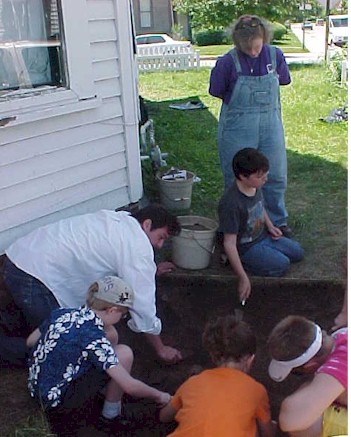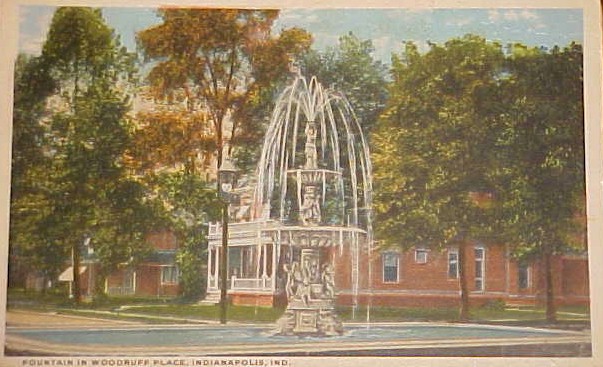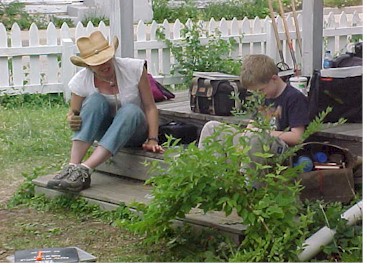|
|
We completed our excavations at the Ward Site the week of June 7 and will finish our summer at Arsenal Tech High School. Click on the Arsenal Tech page for more information on that project |
|
|
Landscape
Archaeology at the Ward Site
By the eve of World War I California Street was lined with
many of the homes that sit there today, and the block had become home to many
well-educated, genteel African Americans who were professionals and
entrepreneurs. These residents' homes were not radically different from
those of their neighbors in much of Indianapolis, but their yards were carefully
cultivated public spaces that were unlike those of most homes in the city's
near-Westside. At 847 North California Street, peonies still persistently
bloom, perennials remain sprinkled throughout the yard, and laid brick sidewalks
and decorative edging remain on the site (or just beneath the surface) today.
Along the street, several back yards have the remains of fish ponds, and flowers
and shrubs hold tightly where they were planted long ago. While many of
these yards only hint at their former glory, they nevertheless indicate how many
California Street residents devoted considerable energy to their homes' outdoor
spaces.
| Contemporary home owners assume that residents will cut their grass, plant flower beds, and install a variety of yard decorations, but archaeology in the near-Westside has shown that until very recently many near-Westsiders probably saw their lawns as more functional spaces: for instance, many residents washed clothes in the yard, kept animals such as chickens, managed small gardens, sometimes cooked in open fires, and often maintained hard-packed swept dirt surfaces, rather than lushly manicured grass lawns. In contrast, archaeology at the Ward Site this summer showed how one series of households manicured their lawn, and it suggestively poses some distinctions between California Street homeowners and many other Indianapolis residents. |  |
| Above: Craig is particularly happy to be sitting alongside a circa 1940 laid brick surface in the California Street back yard. |
 |
The Archaeology Field School excavated a series of units
throughout the front, side, and back yard spaces of the home at 847 North
California Street. These units contained an extremely small quantity of
artifacts, indicating that the yard was generally kept very clean. Most of
the artifacts we recovered were discarded after World War II or along the rear
alley line outside the house lot. In contrast, the near-Westside yards
we've excavated in past field seasons were mostly hard-packed dirt spaces that
were unevenly grassed; this is what the backyards along
Agnes Street looked like
after World War II. The homes along California Street had small front
yards, unlike the Agnes Street homes that were built right up to the streetline.
Homes fronting the street were typical of much of urban America before the
late-nineteenth century, which tended to make urban communities physically and
socially close and contained.
Left: Wade teaches some new archaeologists excavation technique. |
| However, when the Belzs' placed their home off the street in 1890 and gave it a front yard, they were part of a movement that viewed urban homes as private retreats separated from the cityscape by a lawn. This was an idea that was most powerfully realized in the suburbs, including neighborhoods like Indianapolis' Woodruff Place. Woodruff Place was an exclusive elite community built in 1873 for residents hoping to escape the industrialized city. Unlike most of urban Indianapolis, the palatial Woodruff homes had massive front lawns, formal public esplanades, and nine Victorian fountains and many more vases and urns throughout the neighborhood. |  |
The apparently idyllic Woodruff neighborhood was a class-exclusive enclave for genteel Victorians, with entrance walls and fences signaling the neighborhood’s exclusivity. Booth Tarkington was among the aristocratic residents who called Woodruff Place home. In contrast, California Street's modest front lawn expanses would not have matched the pretentious displays of wealth in upper-class enclaves like Woodruff Place and North Meridian Street, but their careful manicuring indicates they inspired pride in residents.
|
|
Right: Jessica walks by a concrete porch foundation and a single row of laid bricks (shown in a larger picture left). The line of bricks along the front of a now-dismantled wooden porch was typical of the modest decorative features found throughout Ransom Place yards in the early twentieth century. |
|
Richmond, Indiana's own Elwood McGuire designed the first mass-produced push mower in 1870, but widespread mowing of uninterrupted ornamental lawn space did not really take off until the turn of the century. The City Beautiful movement was one of the most articulate Progressive voices arguing that beautiful cities would produce social and material reform among urbanites. Most of their energy focused on civic design of parks, road systems, and public architecture, rather than domestic landscapes. Their best-known Indianapolis champion was George Kessler, who planned Indianapolis' boulevard and park system. Even then, though, some urbanites were slow to cultivate manicured lawns. Consequently, the paucity of artifacts in the Wards' yard and the careful attention they and their neighbors showed to their yards suggests that at least some urbanites aspired to construct closely knit urban communities without the material decay many Victorians associated with city life.
 |
|
 |
For more details on the Field School's other summer project, visit our Arsenal Tech web page or the IUPUI News Center's Arsenal project press release. Please contact Paul Mullins if you have any questions about the project.
Page last updated June 20, 2004